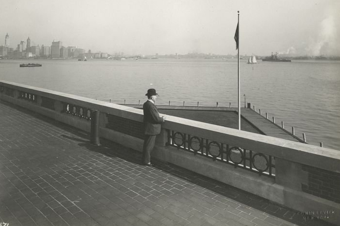Month #4

*UPDATE*UPDATE*: Perseus back on board to deliver the book.
“Birth of a Book” (BoaB) reader Mike Shapiro shared the news with me the very day after I posted my last blog: the Hachette/Perseus deal that I had reported on in Month #2 fell through. Perseus will be the distributor/deliverer of A Tale of Two Citizens.
~ ~ ~
Well, nitty is coming to gritty, Dear Readers, as we have reached five months until publication. (Another BoaB reader observed that it sure takes a long time for a book to be published. Uh, yes.)
A Labor of Love
Since last we met, the galleys arrived (earlier than expected, I might add), and in an unusual turn-of-events, I had all kinds of plans for that week that I had no choice but to bail out on, except that I didn’t reschedule a thing, because I really hate to do that, so let’s just say I worked like mad finding and correcting syllable breaks, font inconsistencies and other miscues by day and going to concerts, birthday parties, and dinners with friends by night. It was a very busy week, that third week of August, but for a writer (for whom, let’s face it, it is a godsend to get away from the desk and be with people), not many things are more gratifying than actually looking at her work on pages, not manuscript sheets, but laid out typeset pages. And, too, this is the last opportunity the author has to catch any last-minute glitches, so that the book is delivered as close to perfect as possible. More on my galley work in a moment, but first:
Keeping with the metaphor that animates this blog, one of the most important things that may happen during the fourth month of pregnancy is the choice to have an ultrasound, amniocentesis, and/or various other tests that help to determine whether there are defects present and the options that are available in the event that there are. I will stipulate here that I am not drawing an equivalency between human life and a book, rather drawing parallels to the timing and development of these two endeavors. Working within the metaphor, then, I couldn’t help but note that the arrival of the galleys and the timing of the prenatal tests occurred in the fourth month of expectancy. The metaphor is holding up. As am I – despite the groaning disappointment (meaning I did a lot of groaning) as I perused and then delved into the task of correcting areas that needed attention. I won’t bore you with how my version of Adobe Acrobat was not sufficiently advanced to work with the PDF sent to me by the publisher. (Surprise, surprise, right?) Suffice it to say that after all the technology apprehension I’ve reported on in this space, I did this very week leap into the future – which is actually the present – and installed a new computer, as well as an upgraded Word program!
But while the typesetter actually did a very good job overall – my manuscript is unusually demanding in that there are several letters that need to be graphically clear as letters, and documents from the period that diverge from the usual straight text in uniform font of most books – the missteps that did exist simply had to be addressed, and they centered mostly on the authentic 1930s government documents that are embedded in the novel.
The documents are part of the story. Beholding from the point of view of the immigrant a communication sent by the government of the United States – what the piece of paper looks like, with all its lines and legalese – is a vital part of the immigrant experience.
At one point in A Tale of Two Citizens, for example, after he has petitioned the government on behalf of his family, Harry, our protagonist, receives such a document, whose content will determine his future, and it simply must look authentic. It must appear in its own font, not a continuation of the font that the rest of the book is printed in, but as a separate, official document, intimidating and scary, and read with a trembling hand.

Of course, I have crossed out and you will learn when you read the book what the Secretary of Labor has recommended to the Secretary of State, but I include this snippet of an authentic replica of a 1930s document to demonstrate how seeing what Harry sees is integral to getting inside his experience. These kinds of documents going back and forth, and including everything from arrest warrants to deportation hearing notices – exactly as they were generated in the 1930s – add color and authenticity to the narrative, and the painstaking work of correcting any oversights in the galleys was nothing more or less than a labor of love.
Fortunately, I did have one more opportunity to go over the galleys after the typesetter applied my corrections, and I am pleased indeed (although I’m sure my mother would find a spelling error somewhere). Did the typesetter do a perfect job? Well, there are still a few glitches. Would I like to go over the galleys once more after my latest round of notes because I want the book to be absolutely perfect? Of course. But word has come down: my work on the physical production of the book is done. There is now only to cultivate and care for it, and do what I can to send it out into a world in which it will thrive.


One of the things that struck me as I was reading the galleys during that third week in August was a tone that sounded oddly familiar. In one specific scene especially, Will Brown, the immigration official in the novel, and Harry’s nemesis, is interrogating a woman whom he suspects of defrauding the government. From the moment he greets her, in his cubicle at Ellis Island, he sounds hostile, suspicious, downright antagonistic.
The voice was particularly unsettling, even more so than when I wrote it. And then I realized: it coincided precisely with the voices we were all hearing coming out of our TV sets, emanating from Ferguson, MO, as police officers and other authority figures pushed and prodded and commanded and distrusted and shot rubber bullets and tear gas at those who were gathered to assert their rights as citizens. Those who have for far far too long been regarded as The Other.
I heard the tone in Will’s voice, circa 1930; we all heard it coming from America’s heartland two weeks ago; and at the end of the fourth month, we can hear the sound of the baby’s heartbeat. Well before delivery, we do all that we can to bring it into a world where it will thrive.
~
Postscript: A heartbeat that was silenced on September 1st belonged to Sam Zwass. Sam’s patient and knowledgeable translation of Polish, Yiddish, and Hebrew documents belonging to my father helped me unfold the world that became this book.



